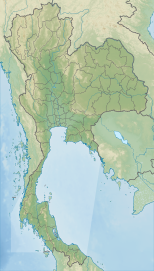| Chiang Saen Lake | |
|---|---|
| Location | Chiang Saen District, Chiang Rai Province, Thailand |
| Coordinates | 20°15′38″N 100°02′46″E / 20.26061°N 100.04606°E |
| Nong Bong Kai Non-hunting Area | |
|---|---|
| Chiang Saen Lake | |
 | |
| Location | Chiang Saen District, Chiang Rai Province, Thailand |
| Nearest city | Chiang Rai |
| Coordinates | 20°15′38.2″N 100°02′45.8″E / 20.260611°N 100.046056°E |
| Area | 22.9914 km2 (8.8770 sq mi) |
| Established | 4 April 1985 Ramsar Site 5 July 2001 |
| Governing body | Royal Forestry Department |
| Official name | Nong Bong Kai Non-hunting Area |
| Designated | 5 July 2001 |
| Reference no. | 1100[1] |
Chiang Saen Lake (Thai: ทะเลสาบเชียงแสน) is a natural freshwater lake in Thailand, it is located in Yonok Subdistrict, Chiang Saen District, Chiang Rai Province, northernmost Thailand.
According to the folklore, the legend of Singhanavati (ตำนานสิงหนวัติ), it used to be an ancient kingdom known as Singhanavati or Yonok. The kingdom was destroyed by a sudden flood from earthquake in one night. Submerged the entire town in a what is known today as "Wiang Nong Lom" (เวียงหนองหล่ม, "drowned town") an archaeological swamp south of the lake.[2]
This lake has a total area of 2,711 rais (1,071 acres). It was originally just a small swamp, until a dam was built to block the waterway overflow until a large lake was formed known as Nong Bong Kai (หนองบงคาย). On April 4, 1985, it was declared as Nong Bong Kai Non-hunting Area.[3]
The lake is home to large flocks of migratory waterfowls which are most plentiful and can be seen at their best from November through February. Bird species found here are lesser whistling duck, grebe, common pochard, watercock etc.
There is a campsite for visitors. Chiang Saen Lake is regarded as the northernmost lake in Thailand.[4]
- ^ "Nong Bong Kai Non-Hunting Area". Ramsar Sites Information Service. Retrieved 18 October 2021.
- ^ "ทะเลสาบเชียงแสน" [Chiang Saen Lake]. MUSEUM Thailand (in Thai).
- ^ "ทะเลสาปเชียงแสน เขตห้าล่าสัตว์ป่าหนองบงคาย" [Chiang Saen Lake Nong Bong Kai Non-hunting Area]. Chiang Rai Focus (in Thai). 2020-04-14.
- ^ "Chiang Saen Lake". TAT.
